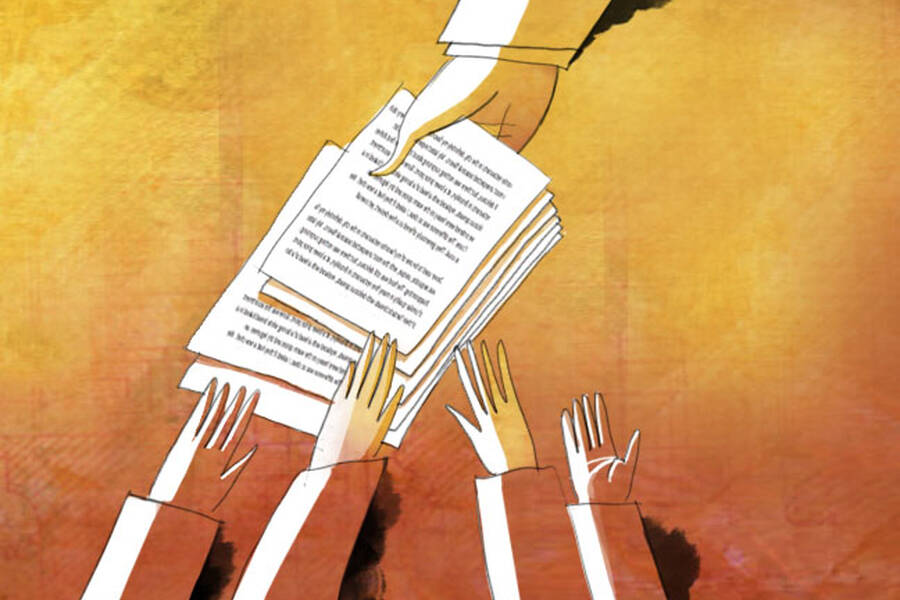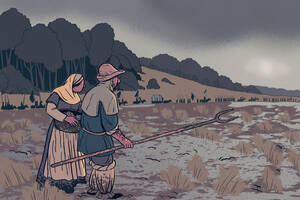Economics Apr 1, 2023
How Marriages Are Exacerbating Income Inequality
Marriage patterns can account for 40 percent of rising inequality, according to a new study.

Yevgenia Nayberg
The income gap between richer and poorer households has expanded steadily over the past 40 years in nearly every region of the world.
And while there are many intertwined and complicated reasons for this, Benjamin Friedrich, an associate professor of strategy at Kellogg, wanted to explore the role of “marital sorting.” Or, more simply put, how much is income inequality affected by who marries whom?
He and his coauthors were drawn to this question because they wondered if previous studies were underestimating the amount of inequality that was caused by marriage-market matching.
Most prior studies looked at marital sorting by the degree level each person obtained, such as a high-school degree versus a bachelor’s degree. But one could imagine that the financial prospects of someone with a bachelor’s degree in business might be quite different than those of someone with a bachelor’s degree in art history, even though they have the same level of degree.
“The educational-level sorting hides all of this heterogeneity, all of these differences in career ambition,” explains Friedrich, who teamed up with Frederik Almar, Bastian Schulz, and Rune Vejlin of Aarhus University in Denmark, and Ana Reynoso
of the University of Michigan.
So the team set out to create a new method of categorizing educational programs. Then they examined whether using these different categories would yield new conclusions about how marriage-matching patterns are changing and if they’re amplifying inequality between households.
Using detailed administrative data from Denmark from 1980 to 2018, the researchers focused on educational ambition—which they defined as the starting wages and wage-growth trajectories associated with various educational programs.
Categorizing individuals this way unearths a clear pattern: over the past forty years, couples have become more likely to self-select into marriages with partners in the same ambition category. The researchers estimated that this trend can explain more than 40 percent of increasing inequality since 1980. In contrast, the sorting trends appear unchanged over this period when the education-level category is used.
“We needed to find the right categorization in order to see its impact—and once we do, we realize that marriage sorting matters for inequality quite a bit,” Friedrich says.
Seeking ambition
The Danish data included more than three million individuals per year, on average, and allowed the researchers to track the education, labor market, and income histories of heterosexual couples.
They used a machine-learning technique to cluster the more than 1,800 education programs in Denmark into four groups of varying levels of ambition, which was defined based on the starting wages and wage growth trajectories these programs tend to yield.
“If the financial returns of going to college have changed relative to going to high school, then marital sorting is becoming more and more important.”
—
Benjamin Friedrich
Programs in the most-ambitious group included some higher-degree programs (like law, business, and medicine) as well as bachelor’s degrees in business. The level below included architecture programs as well as vocational degrees for nurses and carpenters, where starting wages tend to be higher than average, but aren’t as likely to grow at the rate of those in the top group. The third-highest category comprised an eclectic mix of programs—degrees from high schools that specialize in business as well as those from vocational programs training office clerks and bank advisors. These programs have below-average starting wages and relatively high wage growth. The lowest ambition category grouped programs that yield the lowest starting wages and wage growth—like those preparing Danes for administrative jobs in the public sector.
With this new categorization framework, the researchers established that self-sorting into equal-ambition couples increased by about 25 percent between 1980 and 2018.
They also noted additional patterns contributing to increased inequality: marrying within one’s own group is most prevalent among the highest-ambition types—and the share of individuals earning those degrees has increased over the study’s time period. That’s partially due to women’s entry into the workforce since 1980 and, in particular, their joining the ranks of those in the highest-ambition category, which makes the concept of high-earning “power couples” much more prevalent.
Additionally, those with higher-level degrees earn more than they did four decades ago, and that rate has increased faster than it did in the other three groups. That trend alone explains some of the widening economic inequality in society—and the intensification of marriage sorting produces a doubling-down effect.
“If the financial returns of going to college have changed relative to going to high school, then marital sorting is becoming more and more important,” Friedrich says. “The gap widens between the two couples who either met in high school or met in a higher-education level.”
After identifying the level of marriage sorting using these more nuanced categories for education, the researchers wanted to quantify how much it affected inequality overall. So they created a counterfactual: they held the 1980 marriage-matching rates steady across their forty-year study period and then recalculated inequality. “Had we not seen this increase in sorting, what would the counterfactual increase in inequality have looked like?” Friedrich explains.
The answer—that the marriage patterns account for 40 percent of rising inequality—struck Friedrich as remarkable and worthy of future exploration.
Reexamining the drivers of inequality
“There are many implications of these findings,” Friedrich says. For example, take the question of intergenerational transfers of wealth. Previous research has looked at how parents’ educational-degree attainment affects children’s economic outcomes, “but now we’re looking at a different type of classification—and that might have a much bigger impact on the transmission of wealth.”
Though the type of data the researchers used from Denmark isn’t available in the same form for the U.S. population, Friedrich and his coauthors explain in the paper that their new education categorization could work in tandem with survey data, for example, to run similar analyses.
For their part, Friedrich and his coauthors are already working on a follow-up project that examines how, once they match, couples make determinations about who focuses on earning money and who does more work within the household. As Friedrich explains, these sorts of trade-offs can also drive economic inequality.
“Couples with two very steep career paths generate enough income to afford the necessary childcare and other market products that they can use to help support their careers,” he explains. “Others can’t, and in those types of households, we see potentially a lot more specialization [in terms of which spouse raises the kids and which earns money], which then lowers the overall household income.”
Katie Gilbert is a freelance writer in Philadelphia.
Almar, Frederik, Benjamin Friedrich, Ana Reynoso, Bastian Schulz, and Rune Vejlin. 2023. “Marital Sorting and Inequality: How Educational Categorization Matters.” Working paper.



